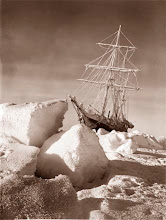Woke this morning to see this ship, the Bahamian-flagged Minerva, a couple hundred yards from my bedroom window.
It's one of two cruise ships expected to stop at Palmer Station this week, and part of a trend of Antarctica tourism going through fits and starts.
It's one of two cruise ships expected to stop at Palmer Station this week, and part of a trend of Antarctica tourism going through fits and starts.
Just as Antarctica has become the chic place for the well-heeled and environmentally conscience to see, the business of bringing tourists to high latitudes in the lower hemisphere is getting trickier.
First, the cruisin' companies have had to deal with their own heavier traffic. Operators go to great lengths to time their journeys in the all-too-brief Austral summer so that they remain largely out of view from one another. It's a bit of a buzz kill to pay a bucket-load of money to have your view of penguins and icebergs cluttered by a another cruise ship.
Then there's the nagging issue of sinking. The Explorer (not to be confused by National Geographic's cruise ship of the same name) shared paint with an iceberg in 2007 about 60 miles from the Antarctic peninsula. The passengers and crew, about 150 in all, were rescued from lifeboats. But the sinking of the Explorer brought about attention to the perils of taking so many people to areas so remote in waters that can be tricky.
Now the countries involved in the uneasy of the no-man's-land of Antarctica want strong new controls.
Now the countries involved in the uneasy of the no-man's-land of Antarctica want strong new controls.
In 2007, the cruise ship Explorer ran into an iceberg less than 100 kilometres from the Antarctic Peninsula . Its passengers were rescued in lifeboats, but the ship sank. It carried 185,000 litres of marine diesel, a lighter fuel, which prevented it from becoming an even worse environmental disaster, according to experts.
Already, rules are set to take effect barring the use of heavy oil on the cruise ships south of 60 degrees latitude, meaning a few companies will bow out rather than retool their ships. Saga, Swan Hellenic and Voyages of Discovery have already steamed away from the continent..
Meantime, the disintegration of the Wilkins Ice Shelf has dumped more icebergs in the water, making navigation harder and meaning and accessibility to some areas less predictable.
The cruises can routinely run tens of thousands of dollars per head. So people talk about the orange parkas their issued for the trip as being $20,000 jackets. Passage on the Minerva, which featured lectures from a scientist who's done much research in the region, included a surcharge that helped pay for scientific gear donated to Palmer on Tuesday.
I climbed on to the Minerva this morning to see the ship and the grip-and-grin ceremony. It was populated by the sort of folks who could afford the money and time for a 10-day Antarctic cruise. Lots of gray hair. And when the folks from Palmer gave a presentation on board, passengers were told they could also watch it on TV in their berths. Later, some 200 rounded through the station for tours and T-shirts.
The cruises can routinely run tens of thousands of dollars per head. So people talk about the orange parkas their issued for the trip as being $20,000 jackets. Passage on the Minerva, which featured lectures from a scientist who's done much research in the region, included a surcharge that helped pay for scientific gear donated to Palmer on Tuesday.
I climbed on to the Minerva this morning to see the ship and the grip-and-grin ceremony. It was populated by the sort of folks who could afford the money and time for a 10-day Antarctic cruise. Lots of gray hair. And when the folks from Palmer gave a presentation on board, passengers were told they could also watch it on TV in their berths. Later, some 200 rounded through the station for tours and T-shirts.





5 comments:
What will I get from the gift shop. Can I shop online? A mug would be nice.
I found the gift shop!
Well, that would burst my bubble. Where are those Somali pirates when you need them?
I have heard that the Bahamas cruise
is the best as i have seen lots
of good review on Bahamas. So i am
interested in that.
cruise deal
What is the carbon footprint to send this ship to the bottom of the world for a bunch of geezers?
KCPL8R
Post a Comment